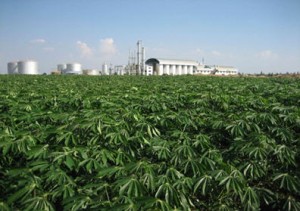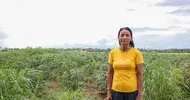Asian Sentinel | 21 October 2010

China and other nations are making Laos an industrial farm, to the detriment of its ecology
Laos, a landlocked and obscure country of 6.8 million poverty-stricken people, is seeking to develop its way into prosperity through massive investment in dams, mines and plantations, hoping for jobs, rising incomes and revenues to end poverty.
But development, a great deal of it by Chinese and other foreign interests, is "tearing at the environment, breaking down the foundations of food production and livelihoods," according to a new 130-page report, titled Development in LAO PDR: the Food Security Paradox, produced for the Swiss Agency for Development and Cooperation and released earlier this month.The report, written by researcher David Fullbrook, asserts that despite the rapid development, food security will remain out of touch for many, especially women and children and in fact is being imperiled.
Wracked by incessant bombing and the dropping of tens of millions of antipersonnel mines by the Americans during the Vietnam War, Laos remains one of the world's poorest countries, ranking 135th in the world. Nearly 41 percent of the population are under the age of 14. It is one of the few remaining one-party Communist countries left on the planet. Subsistence agriculture accounts for as much as 30 percent of gross domestic product, according to the CIA Factbook, and provides 80 percent of total employment.
But, Fullbrook writes, "opportunities are being passed up for increasing sustainable food production for domestic and foreign markets and chronic food insecurity is therefore unlikely to decline and may indeed intensify."
While the government's development goals are "worthy and ambitious," he continues the allure of windfall riches masks a high toll on the environment.
Certainly the environmental change is dramatic. Ten dams are now in operation across the country, generating 669 megawatts of power. Another eight are expected to be operational by 2012, generating 2,531 megawatts. Nineteen more are planned and 42 more are the subject of feasibility studies, almost all of them financed and developed by foreign interests expecting to turn a profit from electricity generation. Thailand is to import up to 7,000 megawatts by 2015. Vietnam will take another 3,000 megawatts by 2015 possibly rising to 5,000 megawatts by 2020 according to an understanding reached in December 2006.
In addition, a wide range of foreign countries are seeking to raid Laos's mineral riches, particularly China and India, who are after substantial potash developments south of Vientiane that could total almost 50 billon mineral tons. Potash is an essential element of fertilizer. There are also a projected 2-2.5 billion tons of bauxite, the ore used to make aluminum. The firs bauxite mine is already under development by a company whose major shareholder is China Nonferrous International Mining, a government-linked company.
Mining is expected to account for 10 percent of GDP by the end of this year, according to government projections, with mining expected to fund a major portion of the government's budget.
China especially is after Laos's considerable other natural resources, particularly rubber, pulp for paper, fuel and starch, "changing the face of the landscape and agriculture in Laos," Fullbrook writes. "Promises of high prices and good incomes are tempting many farmers to switch from meeting the food needs of people to meeting the material needs of industry."
China's Yunnan State Farms has obtained rights to develop 166,700 hectares of rubber in four northern provinces. Officials are assessing 50,000 hectares for cassava plantations after reaching an agreement with China's Zhongxing Telecom Equipment, or ZTE, a leading manufacturer of telecommunications systems. In total ZTE may be seeking 100,000 hectares across four southern provinces.
Other investors are making arrangements with national and provincial authorities to concession or lease for plantations for mono-cropping rubber, eucalyptus, acacia, jatropha, sugar cane or cassava, Fullbrook continues.
An amazing 2 million hectares are being proposed to central authorities for planting in industrial tree crops including acacia and eucalyptus in addition to rubber.
The corollary, however, is that forests are being stripped of foods at unsustainable rates, undoing their ecologies.
"Interests of investors in industrial tree crops may coincide with the government's goal of increasing 'forest' cover from 9 million hectares (42 per cent of land) to 12 million hectares (53 per cent) by 2010," Fullbrook writes.
By 2020 15 million hectares should be under tree cover (70 per cent).
"If forests are taken to mean a great variety of trees and other flora along with fauna growing symbiotically in a diverse, resilient and bountiful ecosystem, then this will be impossible," the report continues. "Or if forests mean uniform variety of trees standing
together then the targets might be hit by planting industrial trees, which is not without precedent elsewhere." However, these developments in dams, mines and industrial forests have severe implications for the environment and the agrarian population who now live on the land. The dams are changing the ecology, not only for fishing but for agriculture as farmers are forced to switch to dry-crop rice from wetland rice as the dams change the face of the country. Rice land is simply disappearing under water. "It is understandable to pursue resources-led investment given the extent of poverty in Laos amid so much natural wealth. However similar strategies elsewhere have with but a few exceptions fallen short of expectations. There is much to suggest that expectations will also fall short in Laos," Fullbrook writes. "Questions of great uncertainty hang over prospects for global production of food with implications, not least Laos, for supplies, prices and food security. Imports of food into Laos at affordable prices are at risk. Events elsewhere are more likely than before to echo in Laos as acute food insecurity."











